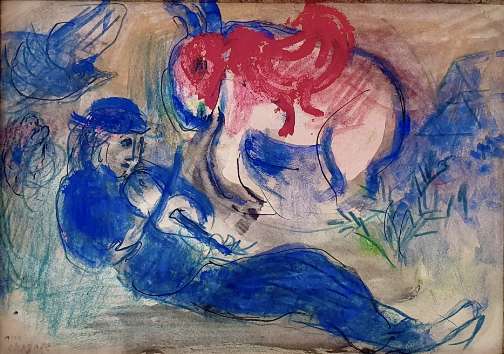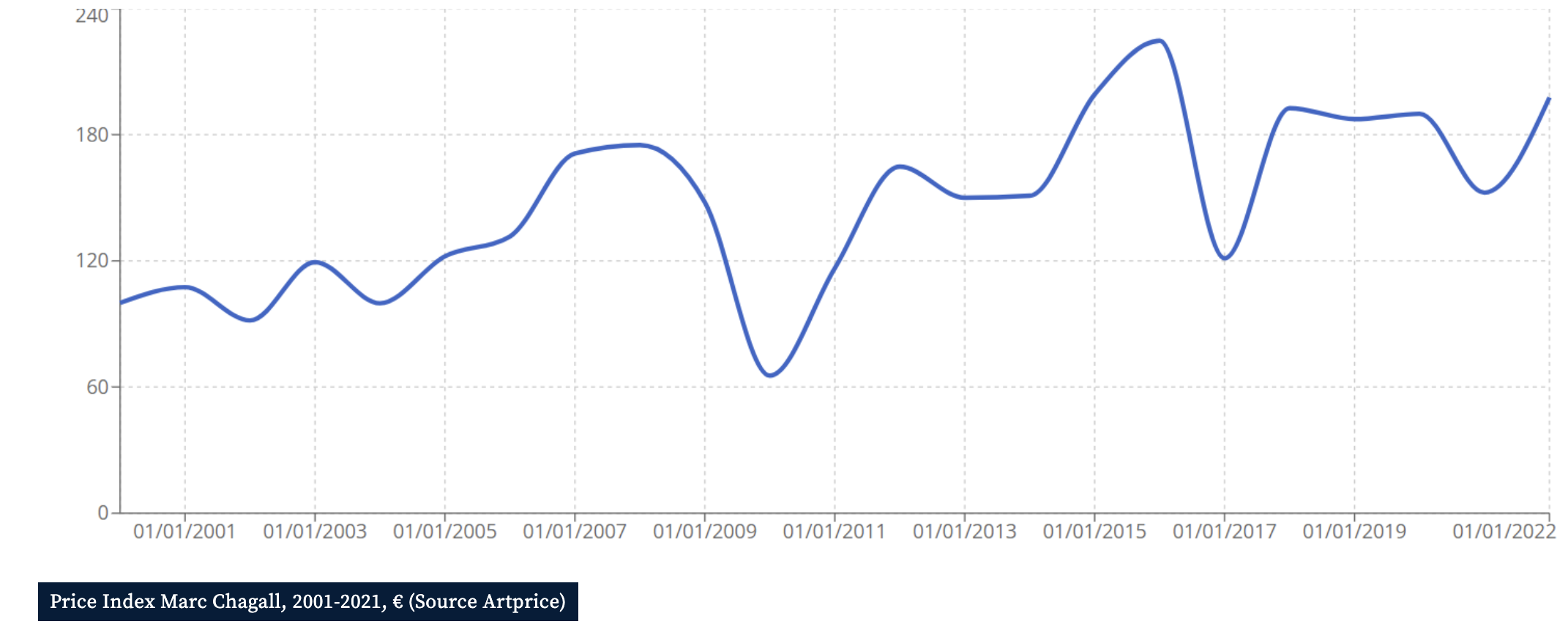
Untitled
By Marc Chagall | 1967

Shares
0 / 1000 available
SOLD
Artwork Documents
Artwork Description
This untitled gouache, made by the artist in his latest production phase, can be seen as a celebration of the symbolism of Chagall’s work and an emphasis of his emotional touch. In a dreamy, imaginative and surrealist landscape, the artist represents a fiddler and a floating cow immersed in an indistinct environment where it is possible to clearly distinguish the leaves of a tree. Connecting to Jewish culture, which has deeply influenced Chagall’s practice throughout his life, the fiddler, a vital presence in religious ceremonies and festivals, represents the communion with God, which is achievable through music and dance. On the other hand, the cow is the symbol of life par excellence, as are the leaves. These essential themes of the artist’s work have been celebrated in the most renowned of Chagall's paintings, such as 'The Green Violinist', 1926 (Oil on canvas - now at The Solomon R. Guggenheim Museum, New York) and 'Cow with a Parasol', 1946 (Oil on canvas - now at MET Museum, New York).
Market Analysis
Marc Chagall is a Blue-Chip artist and his work has always played a primary role in the art market. His artworks can also be found in renowned collections all over the world, such as the Montreal Museum of Fine Arts, the Solomon R Guggenheim Museum, New York, and the Art Institute of Chicago. According to Sotheby’s Mei Moses index, the average compound annual return for a Chagall resold at auction between 2003 and 2017 was 6.8%, and 85% of 294 such works increased in value, especially over the last 20 years, during which he has always ranked amongst the top 40 artists in the world in the Artprice Top List (in 2021, he was n. 27).
In fact, there has been a boom in Chagall's market since 2000. He has very much become a global figure with an international market. His record is $28.4 million for the artwork 'Les Amoureux' (1928), achieved at at a Sotheby's auction in November 2017, in New York.
According to Artprice, £100 invested in a work by Marc Chagall in 2000 would be worth an average of £261 (+ 161%) in December 2021.

Confirming to be a safe haven asset, Chagall’s work quickly recovered the decrease in value registered at the beginning of the pandemic. In fact, from 2020 to 2021, the value of the artist has increased by 24%.
The Artist
A Belorussian-born French painter, printmaker and designer, Marc Chagall created a singularly poetic figurative oeuvre full of rich colours and dreamlike imagery – flying lovers, massive bouquets, melancholy clowns, fantastic animals, lonely fiddlers and vibrant hearts – that made him one of the most popular Western artists of the 20th century.
Born on 7 July 1887, in Vitebsk, in the Russian Empire, Chagall grew up among a devout Jewish community. After learning the elements of drawing at a local school and studying painting in St. Petersburg, he moved to Paris in 1910, befriending such audacious young painters as Expressionist Chaim Soutine and Cubists Fernand Léger and André Lhote, while absorbing the rich hues of the Impressionist, post-Impressionist and Fauvist paintings popular at the time. Responding to these stimuli, Chagall produced works such as I and the Village, 1911, The Fiddler, 1912, and Paris Through the Window, 1913, essentially establishing the whimsical and emotional vocabulary that would characterize his art of the next 60 years.
If the development of his career and the vagaries of two World Wars forced Chagall to move repeatedly between France, Germany and Russia while also spending time in the US, in his private life he experienced two great loves: one, lasting more than 30 years, with Bella Rosenfeld, who appeared in myriad paintings from Birthday, 1915–23, to Around Her, 1945; the other, with Valentina Brodsky, who was featured in several of his later portraits. The artist died in Saint-Paul-de-Vence on the French Riviera, where he had settled with Brodsky.
Marc Chagall's poetic, figurative style made him one of most popular modern artists, while his long life and varied output made him one of the most internationally recognized. While many of his peers pursued ambitious experiments that led often to abstraction, Chagall's distinction lies in his steady faith in the power of figurative art, one that he maintained despite absorbing ideas from Fauvism and Cubism.

